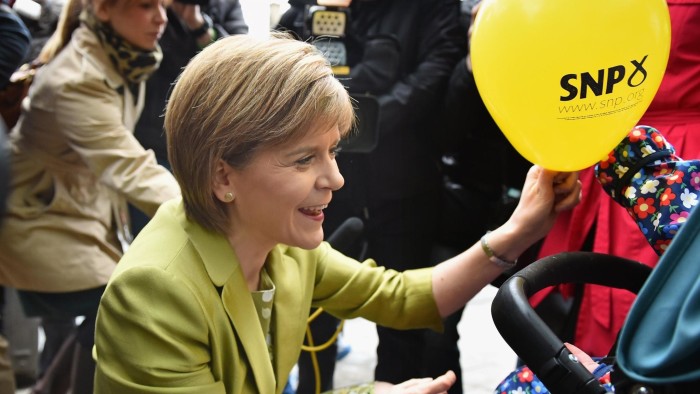Nicola Sturgeon is Scottish National Party’s surging star

Roula Khalaf, Editor of the FT, selects her favourite stories in this weekly newsletter.
It was just a routine campaign stop for Scottish National party leader Nicola Sturgeon when she appeared on Musselburgh High Street, rallied local activists, won over a floating voter, charmed an opponent and departed to chants of “Nicola! Nicola”.
But Ms Sturgeon’s brief visit to the “Honest Town” just outside Edinburgh was emblematic of the way in which the Scottish first minister has dominated the UK election campaign north of the English border.
With just days to go to the May 7 vote, the SNP appears on course to win a Scottish landslide, a triumph with far-reaching implications for UK politics and the future of the 308-year-old union between Scotland and England.
Less than eight months after Scotland’s voters rejected the Nationalists’ vision of independence from the UK by a 55-45 margin, opinion polls suggest the party could win half the popular vote in Scotland and raise the number of seats it holds in the UK parliament from the mere six it won in 2010 to 50 or more.
That could give the SNP a decisive say in deciding who governs the UK in what is expected to be a hung parliament and a platform to push for more powers for Scotland, higher UK government spending and nuclear disarmament.
Analysts say there are many reasons for SNP success, including the rallying of those voters on the losing end of the independence referendum and collapse of the once-dominant Scottish Labour party.
But Ms Sturgeon’s personal appeal is clearly helping. Less bombastic than her predecessor, Alex Salmond, the plain-spoken former community lawyer from a working-class housing estate has widened support among women and those who rejected independence last September.
Behind the political masks

Almost in spite of themselves, nearly all the party leaders have told us something worth knowing.
Continue reading
A YouGov poll for the Sunday Times found 75 per cent of voters in Scotland thought Ms Sturgeon was doing well as first minister.
SNP campaigners adore her, turning her appearances, like the one in Musselburgh, into long series of “selfie” photographs with fans. “She fixed my camera for me,” said one delighted supporter.
A chat with Ms Sturgeon looked likely to gain the vote of undecided passer-by Mary Purves — no small feat since one of Ms Purves’ top policy concerns is the need to control immigration while the SNP stresses the benefits of foreign talent.
After an encounter that ended in a hug and selfie, Ms Purves said Ms Sturgeon had not persuaded her on immigration, but that she was nevertheless now leaning towards backing the SNP on Thursday. “I used to think Alex Salmond looked very arrogant . . . she is totally different,” Ms Purves said.
Even a lone heckler on the Musselburgh street, Conservative party activist Stephen Edwards, was coaxed into a friendly handshake with the first minister. “I think she’s a very, very astute and successful politician,” said Mr Edwards, 76.
Yet for Mr Edwards and many across Scotland, the SNP’s rise remains a cause of dismay.

Ms Sturgeon says victory on Thursday is about giving Scotland greater influence in London and would not be a mandate for another independence push. But she has dropped past acceptance that referendums on sovereignty should happen only “once in a generation” and is keeping her options open.
The SNP also faces fierce criticism over its call for “full fiscal autonomy” under which Scotland would gather all its own taxes and only pay the UK government for shared services.
With oil prices slumping, the policy would imply funding shortfalls in Scotland of £7.6bn or more, according to the independent Institute for Fiscal Studies — a budget crunch that would make the “Westminster austerity” look mild.
Ms Sturgeon has responded by carefully relabelling the goal “full financial responsibility”, tucking it near the back of the SNP's manifesto and stressing it will not be urgently pursued. Even Labour candidates accept the issue has gained no traction with voters.
The SNP’s harshest detractors see this as evidence that Scottish nationalism has become a “mystic cult wholly divorced from reality”, in the words of political commentator Gerald Warner. Yet as Ms Sturgeon criss-crosses the country in a helicopter emblazoned with her photograph, even moderate voters like the idea of her party stirring things up in London.
Indeed the biggest impediment to triumph on Thursday could now be overconfidence among supporters that could reduce turnout.
In the pro-independence The National newspaper, columnist Lesley Riddoch contrasted Ms Sturgeon’s soaring ratings with the unpopularity of Jim Murphy, Scottish Labour’s leader.
“A macho wee country has taken a woman to its heart as leader,” Ms Riddoch wrote. “Jim Murphy can’t stop the SNP now — only smugness and complacency can.”
Comments